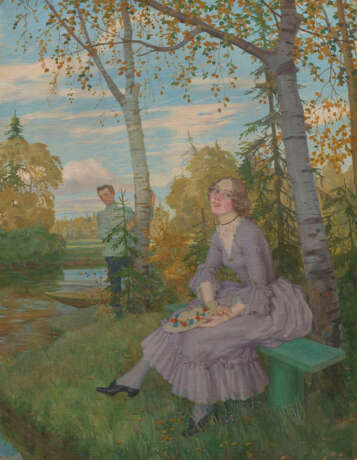ID 70688
Lot 23* | SOMOV, KONSTANTIN (1869-1939) Meeting in the Park , signed and dated 1919.
Valeur estimée
£ 500 000 – 700 000
Provenance: Acquired directly from the artist by A. Zamkov in April 1919.
Collection of N. Kozhevnikov, Leningrad, from 1936.
Important private collection, Europe.
Meeting in the Park is one of Konstantin Somov’s famous “gallant scenes” of the early post-revolutionary years. At that time, near-contemporary figures and events quite often appear in his compositions, replacing the sensual masked balls of the 18th century, the gallant marquises, and the Pierrots and Harlequins. Now we have ordinary, elegant young ladies and their beaux, peasant couples, picnics in the countryside and in the grounds of country estates, bathing parties and firework displays.
The harder life around him became in the late 1910s and early 1920s, the more brightly coloured and carefree Somov’s pictures grew, transforming into a chronicle of the artist’s world of reverie and reminiscence, a wistful stream of idyllic images that were unlikely to have existed previously and were definitely out of place in the new, harsh 20th century. His bright landscapes, flooded with light and invariably providing the background for such gallant scenes, nearly always show favourite spots in the grounds of country estates that the artist had known since childhood — a wooden bench on the shore of a lake, the inevitable birch saplings, shrubs and green lawns.
The very same models quite often feature in these pictures. For instance, the coquettish woman in Meeting in the Park, who is sitting on a bench, holding her hat and seemingly failing to notice the admirer who is watching her, while coyly blushing, is undoubtedly the same model who is the central protagonist in Summer (1919, State Russian Museum). The fresh-faced adolescent girl relaxing in the grounds with a female friend is portrayed in absolutely the same pose and seen from the same angle. The artist merely alters the sitter’s hair colour and dress, and “transplants” her from green summer grass to a bench beneath a birch tree covered with golden autumn foliage. But while repeating his compositional innovations, Somov never actually copies them. Each time, he changes the setting, the detail, the lighting and the colour scheme, and creates new variations on his favourite themes and pictures.
These luminous, outdated daydreams proved to be so popular among patrons that the artist had to return again and again to his most successful pictures, inventing new settings and ringing the changes on subjects that had taken the public’s fancy. So, as the 1910s became the 1920s, there appeared whole series of paintings in which young ladies and their merry companions could be seen “sleeping on the grass” and gazing at a rainbow or firework display. Intrinsically, however, the content of these pictures remains unchanged. Regardless of their historical surroundings and the part they are trying to play — peasant girl, young city lady, histrionic prude or lascivious and haughty aristocrat — Somov’s main female figures are still an expression of the artist’s own outlook on life. The artist once said: “The women in my pictures are brooding; the expression of love on their faces, their sadness or lust are a reflection of myself and my soul… And their unnatural poses … amount to self-mockery and at the same time to mockery of the eternal feminine that is repugnant to my being.”
| Adresse de l'enchère |
MacDougall Arts Ltd. 63 New Cavendish St. W1G 7LP London Royaume-Uni | |
|---|---|---|
| Aperçu |
| |
| Téléphone | +44 20 7389 8160 | |
| Téléphone | +7 495 799 4683 | |
| Fax | +44 (0) 20 7389 8170 | |
| Conditions d'utilisation | Conditions d'utilisation | |
| transport |
Service postal Service de messagerie ramassage par vous-même | |
| Modes de paiement |
Virement bancaire |




